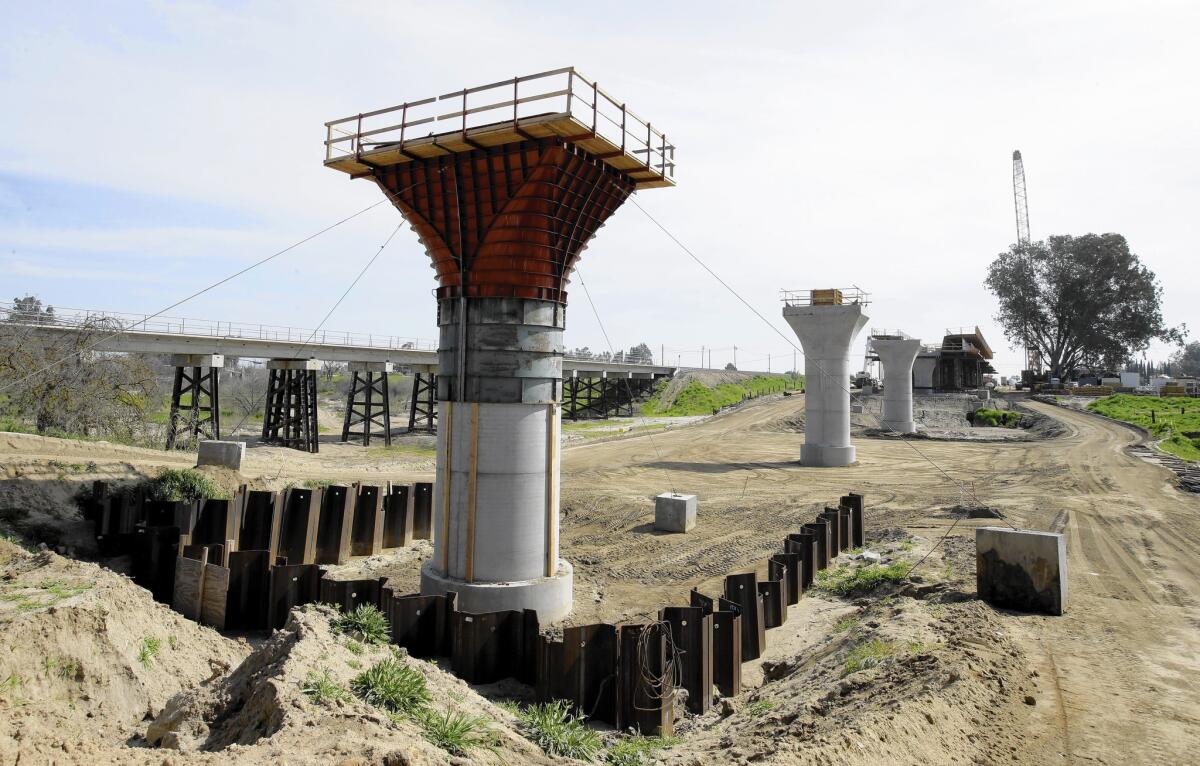Senators share their doubts about bullet train financing with rail officials

- Share via
California’s plan to pay for construction of the $64-billion bullet train has many unanswered questions and shaky assumptions, senators from across the state told rail officials Monday.
“We want you to beef up your financing package,” Sen. Jim Beall (D-San Jose), a longtime supporter of the high-speed project, said at a hearing of the Senate Transportation and Housing Committee, which he chairs.
Republican lawmakers were even tougher. “I think the financing is shaky here,” said Sen. Jim Nielsen (R-Gerber). “It seems like it is careening down the tracks.”
The committee was responding to a draft business plan the California High-Speed Rail Authority released in February. The authority said it could build an initial $20.7-billion operating segment from San Jose to the Central Valley with funding it expects over the next nine years.
But the agency could not identify the source of money to complete the entire Los Angeles-to-San Francisco system. That leaves a $43.5-billion gap in the business plan, scheduled for approval later this month.
The hearing was the first time in several years that the Senate has taken a close look at the project, the first 29 miles of which are being built in the Central Valley. No legislative action is necessary this year, but the issues raised Monday mark an intensifying concern by Democrats that the project is facing far higher risks than they had expected.
Sen. Ben Allen (D-Santa Monica) wondered how politicians can respond to tough questions by constituents, a reality many elected leaders say they are encountering more frequently.
“We have the lieutenant governor talking down the project, and he may be the next governor,” Allen said.
Many of their concerns revolve around the use of greenhouse gas fees to finance about half of the initial segment.
Under the revised business plan, the state would have to extend the greenhouse program until 2050 and give the rail authority permission to borrow against future income from the fees. Representatives of the state Legislative Analyst’s Office warned that many uncertainties exist about that funding, including its potential to diminish.
Sen. Lois Wolk (D-Davis) raised concerns about the fees, asking how much it would cost the state to borrow against them in the future. “Who backs the funding ... if something happens,” she said.
Allen and other senators raised a broad range of concerns, including many based on Times reports that the authority is facing more than 300 change orders in the first construction contract and on a story last year disclosing that consultants had warned of large cost increases.
The rail authority is facing more than 300 pending change orders on just the first construction contract, including a potentially massive $100-million claim by a team led by Sylmar-based Tutor Perini.
Rail authority Chairman Dan Richard deflected questions about those risks. He said the authority has previously disclosed that it could face change orders and emphasized that the agency does not necessarily have to pay them.
Richard acknowledged that state’s failure to deliver parcels on time to Tutor Perini could give the contractor “the right to charge for delays.”
Sen. Richard Roth (D-Riverside) asked about the authority’s responses to an October 2015 Times story saying that the agency decided not to adopt higher cost estimates projected by its lead contractor, Parsons Brinckerhoff.
Rail authority Chief Executive Jeff Morales told Roth that The Times had mischaracterized the cost estimate, but Roth cut him off, saying, “Part of the problem is that it wasn’t released in the first place. People are free to characterize a document that they get. That’s the way it works.”
The Times had asked the state to release the report, in the form of a highly detailed PowerPoint, under the Public Records Act. The rail authority refused the request, declaring it was not in the public interest to release it. The Times later obtained the report from an individual close to the project and gave the state three months to provide detailed responses to questions.
Morales said Monday that higher costs were driven by an assumption that a rail station would be built in Burbank instead of Sylmar. He said the difference required additional miles of track and elevated structures, accounting for the higher costs.
The Parsons Brinckerhoff cost estimate, as well as the state’s previous business plans, never said that a future San Fernando Valley station would be in Burbank or Sylmar.
In the October story, The Times also reported that a second major contractor, URS, said in a 2013 progress report that it expected a $1-billion cost increase in the Central Valley and that it had been ordered by the rail authority to use lower cost estimates.
Richard said Monday that URS’ assertion was not correct, but that he could not discuss details because they were part of a legal dispute with the company.
More to Read
Sign up for Essential California
The most important California stories and recommendations in your inbox every morning.
You may occasionally receive promotional content from the Los Angeles Times.











